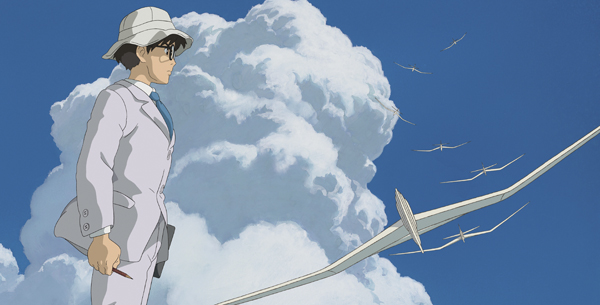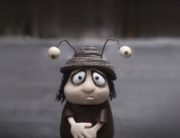Japanese animation master Hayao Miyazaki has announced his intention to retire more than once. So when, upon the premiere of this film at the Venice Film Festival, he once again announced his retirement, there was understandable skepticism in many quarters. However, all indications are that it’s for real this time. Producer Toshio Suzuki of Studio Ghibli, the animation studio Miyazaki co-founded, has made it official. Also, Miyazaki himself has cited his advanced age, failing eyesight, and the lengthy production schedules (due to his insistence on making his films with old-fashioned hand-drawn methods—eschewing computer graphics) as reasons for ending his feature filmmaking career.
The Wind Rises, then, can be described with a comfortable degree of confidence as Miyazaki’s final cinematic statement. And indeed there is an air of the elegiac about it that deeply suffuses the film’s atmosphere. It’s based on the early life of aircraft designer Jiro Horikoshi (voiced in the original Japanese version by Hideaki Anno, another famous animator), best known for designing the Zero fighter. This choice of subject has caused considerable controversy— but more on that later.
Images of flight and aviation run through many of Miyazaki’s films, such as Kiki’s Delivery Service and Porco Rosso, to name just a couple. These images are wedded to the fantastical, kid-friendly animation that has been Miyazaki and Studio Ghibli’s stock in trade. So the fact that aviation is the subject matter here is seamlessly consistent with much of this director’s previous work. And certainly no one would fault Miyazaki for choosing to rest on his laurels and more or less play it safe by offering something of a similar stripe to his other films as his final work.
However, Miyazaki is as much an intrepid adventurer as many of his characters. With The Wind Rises, he boldly stretches the boundaries of his work and steps outside the comfort zone of repeating past glories, creating his first animation aimed at adults. This takes the form ostensibly of a biopic of Horikoshi, but the protagonist is actually a fictional composite of Horikoshi and author Tatsuo Hori, whose novel lends the film its title. Episodes from the book are mixed with details of Horikoshi’s life.
Another point of departure from Miyazaki’s previous work is its grounding in the real world and actual historical events rather than fantasy. To be sure, Miyazaki’s signature flights of fancy are present to a certain extent, but these are confined to dream sequences, where Horikoshi convenes with his idol, Italian airplane designer Gianni Caproni. Otherwise, the rest of the film is devoted to presenting a much more realistic landscape than in other Miyazaki films. Historical events and situations, such as the 1923 Great Kanto Earthquake and Japan’s economic depression, are rendered with vivid visual form and immediacy; the parallels to the present are obvious.
Indeed, it is in the depictions of Japanese history where the issues surrounding The Wind Rises have become quite thorny, and have complicated its undeniable artistry and visual beauty. This mostly has to do with the fact that Horikoshi designed the Zero fighter plane, an aircraft instrumental to the attack on Pearl Harbor and used by kamikaze pilots. Some feel that the portrait Miyazaki paints of Horikoshi as an artistic dreamer obscures, or worse, excuses the historical record of atrocities committed by the Japanese army during this period. However, it should also be noted that in Japan Miyazaki has also come under attack by right-wing advocates of Japanese militarism. They have called him “a traitor” and “anti-Japanese.”
Personally, I take the view that while it is important, and indeed necessary, to acknowledge the full implications of the history, I don’t believe Miyazaki is coming from a stance of being a supporter of, or an apologist for, Japanese atrocities. His essentially pacifist political stance is well established in much of his previous work, as well as in public statements he has made around the time of The Wind Rises‘ Japanese release. At the same time, Miyazaki doesn’t offer the unambiguous mea culpa for WWII crimes that some would like. The closest he comes is in the dream sequence that ends the film, where Horikoshi is confronted by downed, wrecked planes and a ruined landscape representing the ravages of war.
Instead, much of The Wind Rises raises the question of whether form can be separated from function, and what it means to consider Horikoshi as a romantic figure who wanted to create beautiful objects that also caused untold destruction. While this may leave an irresolvable contradiction at the heart of Miyazaki’s film, it also renders his final work a fascinatingly rich and resonant work of art that moves us as much as it unsettles us.

















Leave A Comment